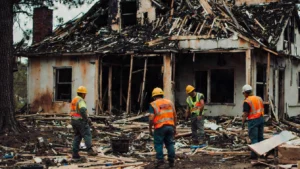What should I know about Asbestos?
O.P. Almaraz:
Welcome back to another session with Q and Allied. My name is O.P. Almaraz and today we’re going to be talking about asbestos-containing materials and how to test for them. Joining me today is industrial hygienist expert, Derrick Russell with Patriot Environmental Laboratories. Let’s go on inside and take a journey.
O.P. Almaraz:
Here we are in a kitchen, a fire-damaged kitchen. We’ve got some suspect asbestos-containing materials. Derrick, let’s talk about why things have to be tested.
Derrick Russell:
That’s a good question, O.P. Well, to put it briefly, the law requires it. The Environmental Protection Agency as well as the state of California makes it mandatory to test certain building materials before they are disturbed.
O.P. Almaraz:
Right.
Derrick Russell:
This is the case with many different kinds of construction projects and renovation projects. Asbestos is a naturally occurring mineral. It was mined and used heavily between the 1930s and the 1980s. It’s also a known carcinogen and is responsible for huge death tolls in the United States alone. That’s why it’s regulated.

O.P. Almaraz:
You bet. Now, let’s talk about what sampling actually entails.
Derrick Russell:
Okay. It’s really very simple. We approach the building material and we try to find a place where we’re not going to create too much damage. Take a small sample while we’re spraying it to reduce dust emissions, put it into a baggy and we transport it to our federally accredited laboratory for analysis. This makes the turnaround time way faster and within 24 hours we can put a report on the desk of the people that need to get involved with this project, make that project go faster, make that claim go faster. Just remember, a state-certified inspector needs to be sampling and doing this to stay in compliance.
O.P. Almaraz:
You bet. You bet. Getting the report back within 24 hours is huge. It’s huge for the claim handler. it’s huge for the contractor, for the abatement contractor, so we appreciate that aspect of it. That’s awesome. Now, let’s talk about this other material here that’s obviously been disturbed. How does that change your process?
Derrick Russell:
Well, it does look like this material was disturbed to the point of contamination.
O.P. Almaraz:
Right.
Derrick Russell:
There’s no fear for alarm. The local EPA, otherwise known as the South Coast Air Quality Management District does require a protocol that is called the Procedure Five Work Plan. It’s a simple work plan that includes photographic images and a site plan, which basically explains how the contamination should be cleaned up and how it should be handled. This way, the abatement contractor can move forward and know exactly how to handle these popular materials the right way the first time, but be careful because if this protocol isn’t followed or written huge fees can be levied on all parties involved, including the homeowner.

O.P. Almaraz:
I’m glad you mentioned that. That’s something that, as contractors, we’re so always keenly aware of and we’ve got to be careful of. Derrick, let’s fast forward. You got the licensed asbestos contractor has just completed his scope of work. Now, what’s your process?
Derrick Russell:
The last step of this process is the final clearance. Now remember, the final clearance can also only be done by a state-certified inspector. The objective behind the final clearance is to double check on the work that the abatement contractor performed, make sure there’s no residual asbestos-containing material left behind. What this involves is a visual inspection and an air sampling of the work area to verify that it’s safe, breathable, and ready for re-occupancy. Once these samples are taken, they’re submitted to our federally-accredited laboratory. The results are then compared to a EPA standard. That’s how we stay in compliance.
O.P. Almaraz:
Awesome. After that’s done, then we can come in as general contractors and get things started. Is that right?
Derrick Russell:
Exactly.
O.P. Almaraz:
That’s awesome. Derrick, thank you so much, man. I really appreciate your time. To you all, I hope this is giving you some insight on what the industrial hygienists do and the processes they go through to give us the reports that we need. Thanks a lot.








